joshuaream
Silver Member
- Joined
- Jun 25, 2009
- Messages
- 3,170
- Reaction score
- 4,512
- Golden Thread
- 0
- Location
- Florida & Hong Kong
Discussions related to North American Indian artifacts. Canada/USA/Mexico.
I've been slowly downloading my old photos from Photobucket since they went all fee crazy, and figured I'd post something here. These fall under the Mexico part of North America.
These three artifacts in this post were part of an eBay collection I bought several years back of some great Mezcala artifacts. The seller was listing lots of small beads that were listed in the right category but weren't selling well as she wasn't describing them and didn't know the culture, so I was usually the only bidder. She sent me a note in one of the boxes with some pictures of what else she had, and we made a deal. A relative of hers bought them years ago and they were in a box she got when he died.
These are small versions of the classic Mezcala artifact, the stern figurine. It's pretty rare that an ancient culture came up with such a uniquely abstract way of displaying the human face and body. A couple of lines to denote the eyes, mouth, neck and body features, but some of them are really quite beautiful. This culture lines up timewise with the Adena. (Around 1000 BC-200 BC.)
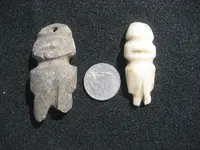
This is a less common style, made on a piece of local greenstone that is typical for artifacts from this area.
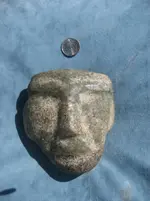
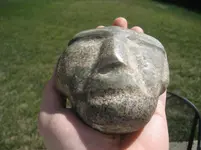
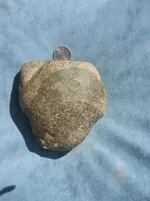
One of my favorite Archaeological sites is Teotihuacan (Pyramid of the Sun, Moon, etc.) It's a very cool place, and the surrounding fields and city is filled with artifacts. I purchased these from an older collector who bought them decades ago. These little figurines are pretty common, the larger one has a matching headdress. They are thought to represent dead people, so if you click the picture you can see a larger photo which shows kind of the blank stare/mouth open dead face. This culture lines up with the Hopewell in the US (200 BC - 400 AD), and there has long been debate if either group had at least a vague knowledge of each other.
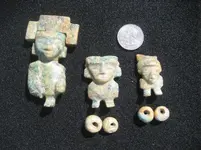
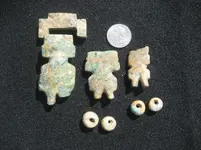
Aztec or Mixtec Obsidian Earspools/labrets. The Aztecs were around when the Spanish arrived, but they were in a constant struggle with other groups in the central valley of Mexico. These groups line up with the Mississippian. The Caddo in Oklahoma had an obsidian flake from a quarry near Mexico City, so there is some indirect evidence of trade through neighboring groups... They might not have known each other directly, but via neighbor of a neighbor of a neighbor ideas, technology and occasionally material moved north and south. (You see some very similar shell gorgets with hawk, eagle, eye, hand motifs, similar mounds/pyramid shapes, similar layout at some ceremonial centers, discoidals, monolithic axes, large bifaces/dance swords, etc.)
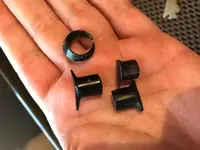
I've been slowly downloading my old photos from Photobucket since they went all fee crazy, and figured I'd post something here. These fall under the Mexico part of North America.
These three artifacts in this post were part of an eBay collection I bought several years back of some great Mezcala artifacts. The seller was listing lots of small beads that were listed in the right category but weren't selling well as she wasn't describing them and didn't know the culture, so I was usually the only bidder. She sent me a note in one of the boxes with some pictures of what else she had, and we made a deal. A relative of hers bought them years ago and they were in a box she got when he died.
These are small versions of the classic Mezcala artifact, the stern figurine. It's pretty rare that an ancient culture came up with such a uniquely abstract way of displaying the human face and body. A couple of lines to denote the eyes, mouth, neck and body features, but some of them are really quite beautiful. This culture lines up timewise with the Adena. (Around 1000 BC-200 BC.)

This is a less common style, made on a piece of local greenstone that is typical for artifacts from this area.



One of my favorite Archaeological sites is Teotihuacan (Pyramid of the Sun, Moon, etc.) It's a very cool place, and the surrounding fields and city is filled with artifacts. I purchased these from an older collector who bought them decades ago. These little figurines are pretty common, the larger one has a matching headdress. They are thought to represent dead people, so if you click the picture you can see a larger photo which shows kind of the blank stare/mouth open dead face. This culture lines up with the Hopewell in the US (200 BC - 400 AD), and there has long been debate if either group had at least a vague knowledge of each other.


Aztec or Mixtec Obsidian Earspools/labrets. The Aztecs were around when the Spanish arrived, but they were in a constant struggle with other groups in the central valley of Mexico. These groups line up with the Mississippian. The Caddo in Oklahoma had an obsidian flake from a quarry near Mexico City, so there is some indirect evidence of trade through neighboring groups... They might not have known each other directly, but via neighbor of a neighbor of a neighbor ideas, technology and occasionally material moved north and south. (You see some very similar shell gorgets with hawk, eagle, eye, hand motifs, similar mounds/pyramid shapes, similar layout at some ceremonial centers, discoidals, monolithic axes, large bifaces/dance swords, etc.)

Amazon Forum Fav 👍
Last edited:
Upvote
0




